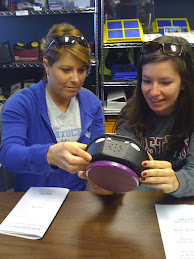Looking at language - is the focus of this class. What does it mean to "compare and contrast" is something we have discussed. When/how do we teach students to do this? We continually refine our skills comparing and contrasting based on the complexity of objects, concepts or philosophies we are analyzing.
Last test you were asked to demonstrate your understanding of phonemes and morphemes by comparing and contrasting them. On this test I have asked you to compare and contrast syntax and semantics to demonstrate to me how well you understand how they are similar and how they are different.
I am going to share in the comments section of this post student answers from the first test that most demonstrated to me a clear understanding of how phonemes and morphemes connect to language.
I encourage you to review these to deepen your own understanding phonemes and morphemes. I also encourage you to use these as models as to how to answer a compare and contrast type of question. There are various ways they answered the question - but each one showed how the two concepts were similar and how they were different.
Feel free to post questions here that you may have on these topics or start a new post.
3/19/09
Subscribe to:
Post Comments (Atom)






Sample/Model Compare/Contrast Answer One
ReplyDeletePhonemes and morphemes are both important elements of a language. Phonemes are the smallest unit of sound in a language while morphemes are the smallest unit of meaning. These two are similar in that they are basic building blocks of a language and both can signal a change in meaning. These words sound very similar as well, but there are also some differences between them. Phonemes consist of single sounds that can be combined to create morphemes. Morphemes consist of letters and sometimes words that represent a meaning. A morpheme is the smallest unit of meaning, so it may not always be a word or a syllable.
Sample/Model Compare/Contrast Answer Two
ReplyDeleteOne similarity between phonemes and morphemes is that additional phonemes and morphemes or changes in phonemes and morphemes will signal a change in the meaning of a word. For example, take the word “jet” and say I change the phoneme /j/ that is in this word to /p/. The word then becomes “pet” and the meaning of the word has changed. By changing or adding morphemes to words you can do the same thing. An example of this would be if I were to take the word “jumps” and change the bound morpheme /s/ to /ing/, then the word would become “jumping,” which has a different meaning than “jumps.” Both phonemes and morphemes also have rules that govern how they can be combined. In phonology (at least in English), you will not see /j/ and /w/ occur together. Similarly, the bound morpheme “ing” must occur after other morphemes. These are examples of how both phonemes and morphemes are rule governed. The difference between phonemes and morphemes is that phonemes do not carry meaning on their own while morphemes do. Even bound morphemes carry meaning. For example, that we know that “s” signals more than one. However, phonemes cannot carry meaning without being combined with other phonemes.
Sample/Model Compare/Contrast Answer Three
ReplyDeletePhonemes deal with units of sound, whereas morphemes deal with units of meaning. Morphemes can be bound with prefixes and suffixes. However, phonemes cannot be “bound” in the same way as morphemes. Phonemes are the smallest unit of sound that when changed, may also alter the meaning of the word. Morphemes are the smallest unit of meaning, and when changed they too can alter the meaning of the word. They both maintain the ability to change and alter the word’s definition
Sample/Model Compare/Contrast Answer Four
ReplyDeletePhonemes and morphemes are similar in that they are both elements of language. Also, according to Bloom and Lahey, they both fall into the language element category of form. Phonemes and morphemes are similar because they both can change the meaning a word, but they are different because they change the meaning of the word in different ways. For example, different phonemes can change the word “cat,” to the word “cut”, which do not have the same meaning. Morphemes can change the word “cat,” to the word “cats,” which also do not have the same meaning. Another difference between the two is that while they are both very small units in language, phonemes are the smallest units of sound that can distinguish a difference in meaning and morphemes are the smallest units of meaning.
I just finished Test 2. This has helped me out greatly in terms of the first question regarding syntax vs. semantics. I really appreciate you putting this up here! Hopefully my answer was a little better than the first compare and contrast answer I had for Test 1!
ReplyDelete